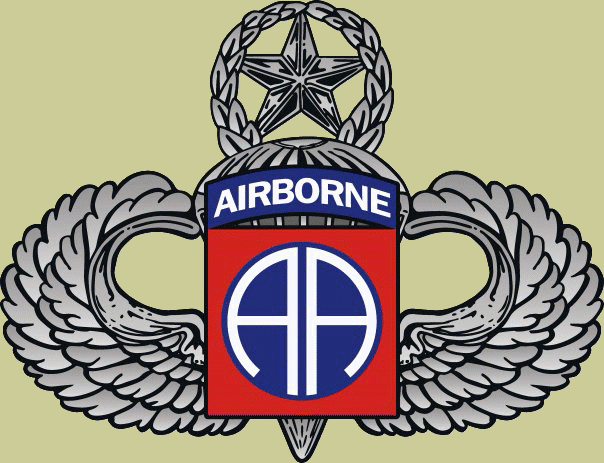
82nd Airborne
Division
(In the
Second World War)
The 82nd Infantry Division, was originally an unit with its
roots in the First World War, and known as the ‘All American’,
due to the effect that it’s service personal came from all
states in the United States. In March 1942 it was reactivated
at Camp Clairborne, Louisiana. On 16 August of the same year
the 82nd was divided to form the first American Airborne
Division, together with the 101st 'Screaming Eagles' Airborne
Division. The 82nd moved directly to the
training camp Fort Bragg, North Carolina. Part of the division
becomes the 504th Airborne Infantry Regiment that was called
into life at Fort Benning, Georgia.

Col. James M. Gavin, 505th PIR CO,
inspecting his troops in Oujda, Marocco
The 82nd AD, under command of Major General Matthew B. Ridgway, left New York by ship at the end
of April 1943, and reached North-Africa after 12days at sea, on May 10. They disembarked at Casablanca,
Marocco. There First camp was near Oujda. They stayed here for six week and during this period did training
for the battles to come. An advanced unit of the 82nd, was brought by truck to Tunisia, towards the frontline
at Kairouan, to settle a camp. Between June 21 and July 6, the rest of the 82nd Airborne were flown in by plane.
Operation 'Husky'
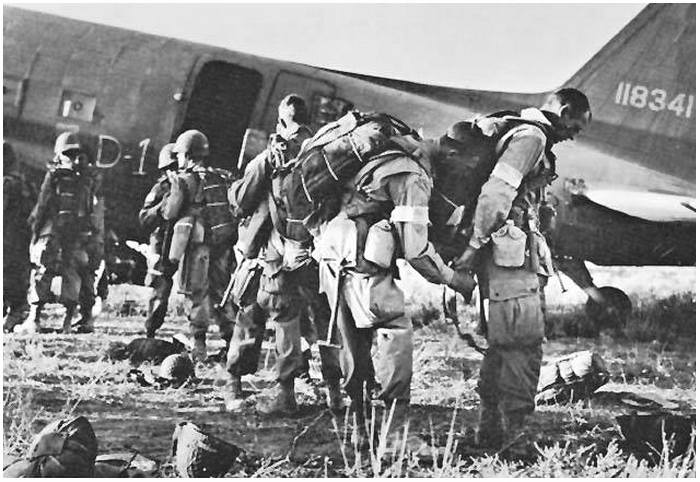
The 82nd Airborne Division ready to jump over Sicily
In Tunisia the division prepares for
the invasion of Sicily. ‘Operation Husky’ takes place in the
night of 9 and 10 July 1943 when units of the 82nd Airborne
Division, consisting of the 505th Airborne Regiment and the
3rd Battalion of the 504th Airborne Regiment step aboard their
transport planes for there jump over Sicily. The First units of the 82nd that
would jump into action were; the 505th PIR, 456th PFAB, and Company 'B' of the 307th AEB and the 3rd Battalion 505th PIR.
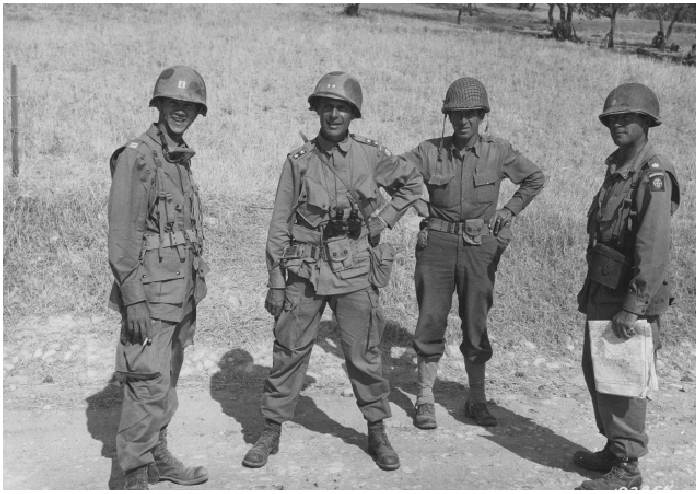
Major General Matthew B. Ridgway (midden)
nabij Ribera, Sicilië, 25 juli 1943
When the C-47's approach the island the American navy opens
fire at them by mistake, they thought that the planes were
from the German Luftwaffe. Despite that there are a couple of
C-47’s destroyed with the costly price of the life of many
young men, the main force with the ‘All American’ reach their
drop zone. Ten days later the front troops are withdrawn. When
the allied landings near Salerno in Italy are under threat to
fail, units of the 82nd were swiftly brought in on 13
September, 1943. The Airborne Division manages to force a
breakthrough to Naples.
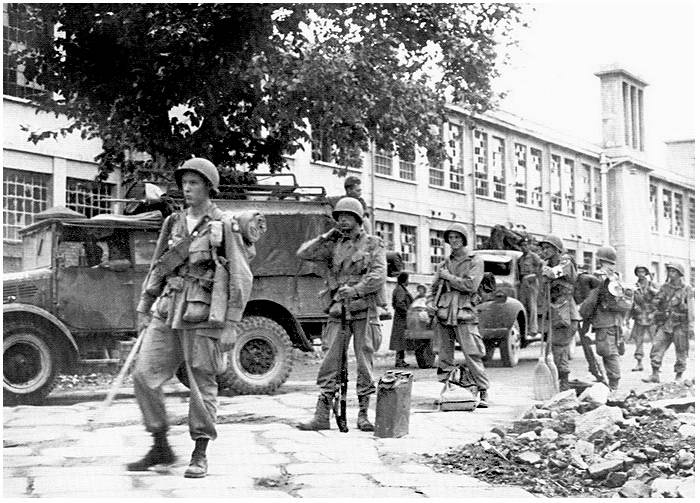
De 82nd Airborne
Division in Napels
The 504th Parachute Infantry Regiment
receives in Bagnoli, out of hands from Major-General Mark
Clark, the Presidential Unit Citation for their part during
the Anzio campaign.
Now that Naples was secured, the 82nd was shipped to
Liverpool where they arrive on 22 April, 1944. The division
goes in training for their next mission, D-Day.
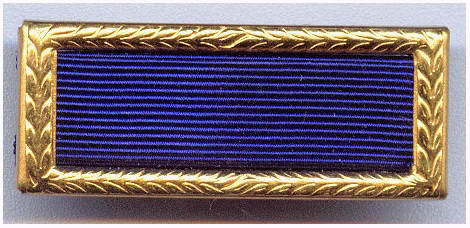
Presidential
Unit Citation
6 JUNE, 1944, D-DAY
The targets for the 82nd Airborne Division on 6 June, 1944,
were west and south of Ste-Mere-Eglise. Their mission was to
destroy two bridges over the river Douve and to secure the
bridge over the river Merderet. This to prevent that the
Germans could bring reinforcements to the landing beaches. The
first group that were dropped were the ‘Pathfinders’. Their
mission was to place the beacons for the main force of C-47’s.
Unfortunately only 38 of the 120 ‘Pathfinders’ reach their
specific target.
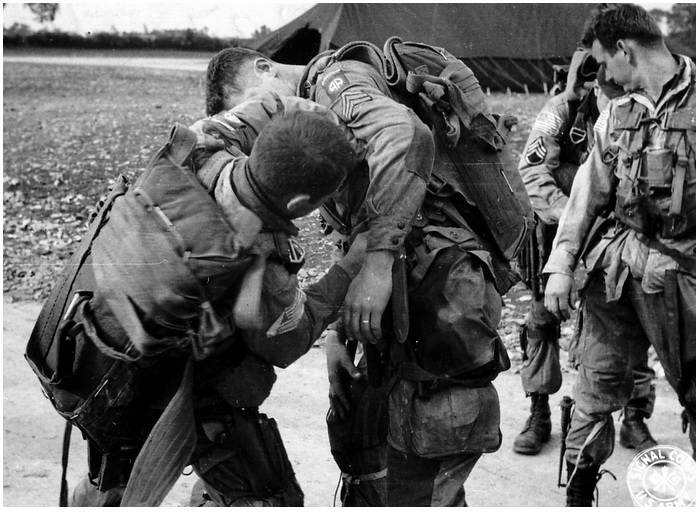
'All American' troopers
are getting ready to go to France,... a jump into darkness
After the first men have made their jump the
German flak becomes more intents. The pilots try to climb
their planes and to throttle up. This made the jump for the
men much harder. Due to the fact of the bad weather and the
lack of radar the flak was very inaccurate. Of the 805
transport planes that flew that night over the peninsula
Cotentin, ‘only’ 20 were lost because of the flak.
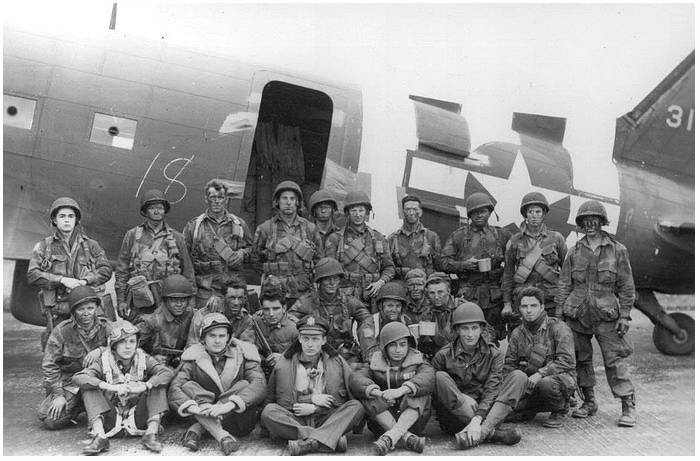
Pathfinders from the 508th
PIR who will mark the DZ's
The 82nd,
under command of Major-General M.B. Ridgway were fortunate.
The first regiment, under the command of Lieutenant-Colonel
Krauze, drops in by surprise with 75% of the men within a few
miles of their target (dropping zone, DZ). At 04.00 hours, two
hours after the main force has landed, Ste-Mere-Eglise is captured.
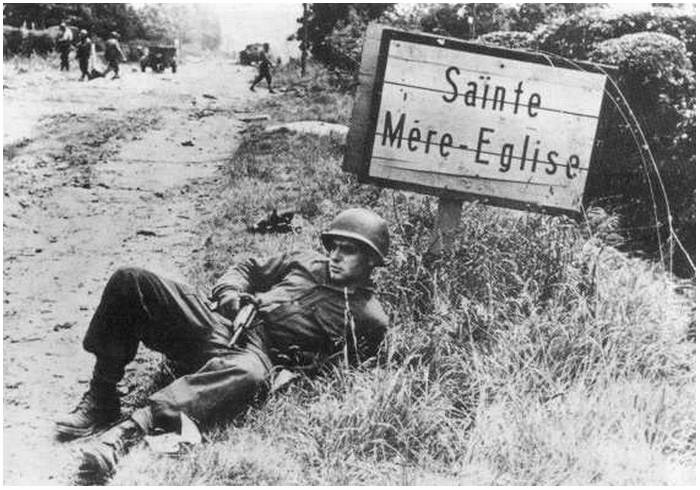
But the problems started to grow. Of the 52 gliders loaded with the heavy
weapons, only 22 reach their landing zone (LZ). The bridges
that had to be taken were strong defended. Further more, a lot
of paratroopers were lost wandering around in search of their
units. A whole group was lost between the river Merderet and
the area that was intently swamped. The Germans predicted a
landing in this area, and whole area’s were drowned and were
impenetrable. Everywhere in the field stood high poles against
gliders, the so called ‘Rommels-asparagus’.
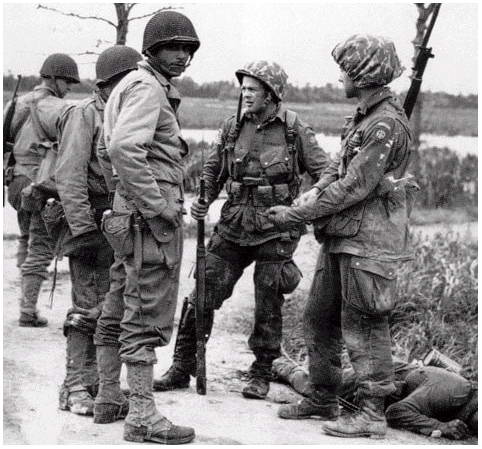
Links: 82nd Airborne troopers
talk to men from the 4th Infantry Division
Due to the
scattered landings of the paratroopers in the whole area, there were
small conflicts with the Germans. It was for the defending
German a nightmare. All around them were small groups of
paratroopers. In this area operated the German 91st Infantry
Regiment, special trained to deal with paratroopers, but there
was no strategy in the fighting of the 82nd Airborne Division.
At daybreak of the 6th of June the reinforcements arrive in
gliders or were dropped. Around 10.00 hours in the morning the
first contact is made with the troops who landed at UTAH
Beach. There is a firm bridgehead with a depth of 12
kilometre. The 82nd Airborne Division is appointed to break
out to the west and close off the peninsula Cotentin and
secure it against retreating Germans from the north. Four
other American Division will then steam up north, to Cherbourg. On 18 June, the 82nd
reaches Barneville on the other side of the peninsula. At
least 30.000 German soldiers are trapped and these pull back
on Cherbourg.
A small unit of the 507th PIR fought against heavy German oposition
when they were trapped in the village of Graignes. For the whole story:
'CLICK HERE'
After 33 days of non-stop fighting, the 82nd is finally
evacuated back to England. The losses were 40% of the initial
strength from the month before. The troops had fought against
five German divisions, 77th, 353rd, 243rd, 91st and the 265th,
in which case the last two were almost wiped out. Further
more, they destroyed 62 tanks and 44 pieces of artillery and
anti-tank cannons.
One Medal of Honor was awarded in this period. 2.PFC Charles N. Deglopper was trapped
with his men by a German opposition. Deglopper took up his machinegun and positioned himself
in the middle of a road, and began firing towards the Germans. This evasive action gave his
men the change to retried to a save place. Later Deglopper was found, lying in a heap of
spelled shells, killed by the German. It would earn Deglopper his Medal of Honor.
17 SEPTEMBER, 1944,
MARKET-GARDEN
During their period in Great Britain the 82nd and 101st were
brought back to fighting strength and prepared for their next
operation, Market-Garden. Their target was the capture of several
bridges, with the final goal the bridge at Arnhem. Montgomery
had the idea to use this point to spearhead into Germany. The British
1st Airborne Division would be landing west of Arnhem, with
support from the Polish Parachute Brigade. The 101st Airborne
Division had its DZ in a area between Veghel and Son, north of
Eindhoven. The 82nd would be dropped between the river Waal and
the river Maas, south of Nijmegen. Under command of
Major-General James Gavin their task was to capture the
bridges, among them the longest (then) in Europe, over the
Maas near Grave.
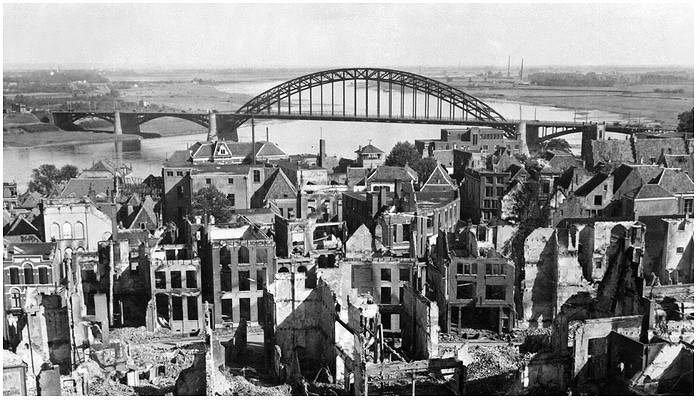
The bridge at Nijmegen
On sunday 17 September, 1944 a 1000 transport
planes and almost 500 gliders fly to Holland. The Americans
who dropped in the area Eindhoven-Nijmegen faced little
opposition, other than the British, who were under heavy fire
from the start. A battalion of the 82nd Airborne Division
captured the bridge near Grave within the hour. Before dark
set in, the route leading into Nijmegen was secured by capturing
the bridge over there. The next day, 18 September, the counter
attack from the Germans began from the Reichswald. This was around
the same time when the reinforcements of the 82nd were due to
arrive. From England 1203 gliders started that morning. They
left late because of the bad weather. At that time the LZ for the
gliders was overrun by the Germans. General Gavin ordered to
clear the landing zone from Germans. With only thirty minutes
to spare the paratroopers pushed the Germans back. But the
gliders landed under heavy fire, but despite of that, the casulties
were minor. Had the gliders left on time from their airfields,
they would have landed in a by Germans captured area. But
because of their late arrival it was to late to capture the
bridge of Nijmegen that day.
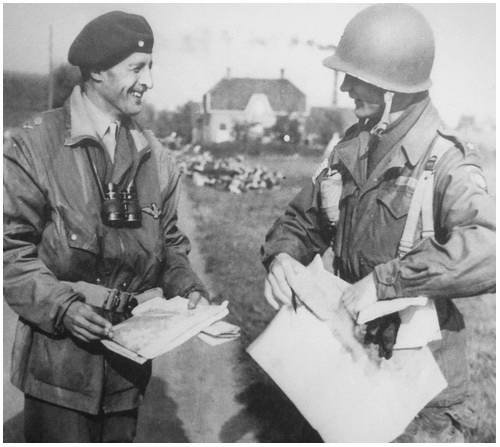
Lieutenant-General 'Boy' Browning converse with
Major-General 'Jumping Jim' Gavin
In the night of 19 and 20 September German reinforcements
were brought in over the Rhine to Nijmegen. These were units
from the battle-group 10.SS-Pantzer-Grenadier-Division. It took
most of the Wednesday to clear Nijmegen from German defences
in and around Nijmegen, and at the shore of the river Waal.
This was of great importance because the 504th Parachute
Regiment were given the order to cross the Waal with boats.
Around 15.00 hours the men boarded the rowing boats and under a
smokescreen they set off. Unfortunately the wind blew the
smoke apart and the fast flowing river made it hard to row.
Only half of the boats reached the other side, the rest was
adrift or were destroyed by German fire. But somehow 200 men
reached the other side and with additional reinforcements they
captured the bridge. There was no medal big enough in the world for this
heroic act, to cross a fast moving river of 400 metres wide in
brought daylight under heavy enemy fire. General Dempsey told
General Gavin: "I'm very proud
to meet the commander of the finest division in the world
today". All of the British officers who witnessed the 82nd Airborne Division on
that day, agreed with this
wholeheartedly, how they fought the river, the Germans, and against death,…
Despite their heroic effort, not a single Medal of Honor was handed out to an 82nd trooper,
they ‘just’ did their job.
During the whole of Operation Market-Garden, one Medal of Honor was awarded
to a paratrooper of the 82nd Airborne Division. On September 21, near Oosterhout,
John R. Towle, from 504th PIR, was sitting in his foxhole. When he noticed that some
German tanks, and at least a 100 men, were approaching, he knew at once that not only
his position and that of his mates were in danger, but also the complete bridgehead
was in jeopardy. Towle took his Bazooka and ran unprotected to the top of the dyke.
Despite the incoming German bullets, he managed to hit two tanks, which retrieved.
Towle saw nine Germans enter a house, and at once he fired a shot into it, which killed
them all. After that, he ran at least 125 meters further upon the dyke, to fire at an
armoured car. But an incoming mortar hit Towle, which killed him instantly. On March 15,
1945, Towle received the Medal of Honor.
Unfortunaly, Arnhem would not be liberated and the British
had to give up their positions at the bridge overthere. The planned
breakthrough to the east before the winter had failed.
FROM BELGIUM TO
BERLIN
When the 82nd and the 101st Airborne Division were pulled
back to take some rest, the ‘Battle of the Bulge’ began in
the Belgium Ardennes. In great hurry the 101st was directed to
Bastogne and the 82nd took positions on the left flank.
During the total isolation of the 101st at Bastogne, the 82nd
hold of the Germans west of Bastogne with the help of the 17th
Airborne Division.
On Januari 29, 1945, a small group from Company C of 508th PIR moved through Holzheim,
Belgium. When the leading officer was wounded, Sergeant Leonard A. Funk Jr. took over
his roll. When the group searched the houses, some 30 Germans were taken prisoner.
After Holzheim was cleared, they had at least 80 Germans in their custody, and placed
under guard by four paratroopers.
A German patrol attacked the American troopers, and freed the German prisoners. When
Sergeant Funk went around a corner, he was confronted by the German group. A German
officer pushed a sub-machinegun into the stomach of Funk, and ordered him to surrender.
Funk slowly let his sub-machinegun slide over his arm, and set his weapon from safe to
fire. In one fast move, he opened fire, and shot the officer, and turned his weapon
towards the other Germans and shot some of them. He shouted to the American troopers,
to grab German weapons and shoot at them. After the short fire exchange, 21 Germans lay
dead and a double was wounded. The Germans that surrendered were again placed under guard.
On September 5, 1945 Sergeant Funk received the Medal of Honor.
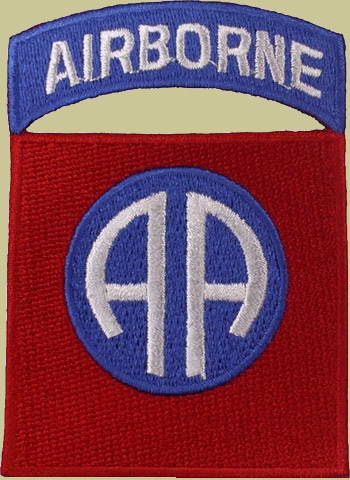
When finally the Germans were defeated and
drove back, the pursue of enemy troops takes over. The river
Rhine was crossed and the allies headed for Berlin. The 82nd
crossed the river Elbe together with British units. 50
Kilometres further, in Ludwiglust, they shook hands with the
Russians. Meanwhile they liberated the concentration camp of
Wobbelin and they accepted the surrender of 145.000 German
troops from the 21st Army, under command of General-Leutnant
von Tippelskirch. After VE-Day (Victory Day-Europe) the 82nd
Airborne Division was tasked to be a administrate force and policing
the American sector in Berlin.
In the Second World War, 1619 paratroopers of the 82nd would be killed, 6560
were wounded, and 332 para’s would die of their wounds. Three Medals of Honor were awarded to members
of this division.
The shoulder sleeve insignia of the 82nd Infantry
Division
The original shoulder sleeve insignia of the 82nd Infantry
Division dates back to the First World War and was accepted on
21 October 1918. It consist of a red square with a blue circle
bearing the white letters ‘AA’ (All American). When on 31
August, 1942 the 82nd Airborne Division is reactivated the
same insignia is accepted with the addition of a half circle
with the word ‘Airborne’ above it.
To the 101st 'Screaming Eagles' Airborne
Division.
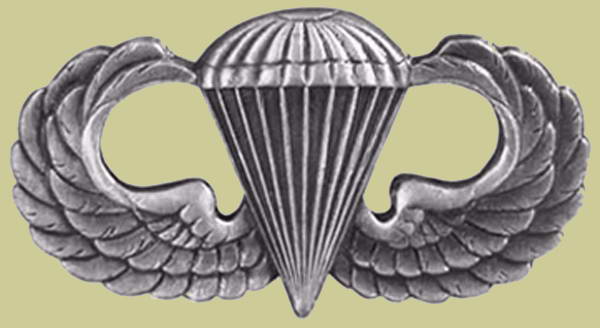
RETURN
|